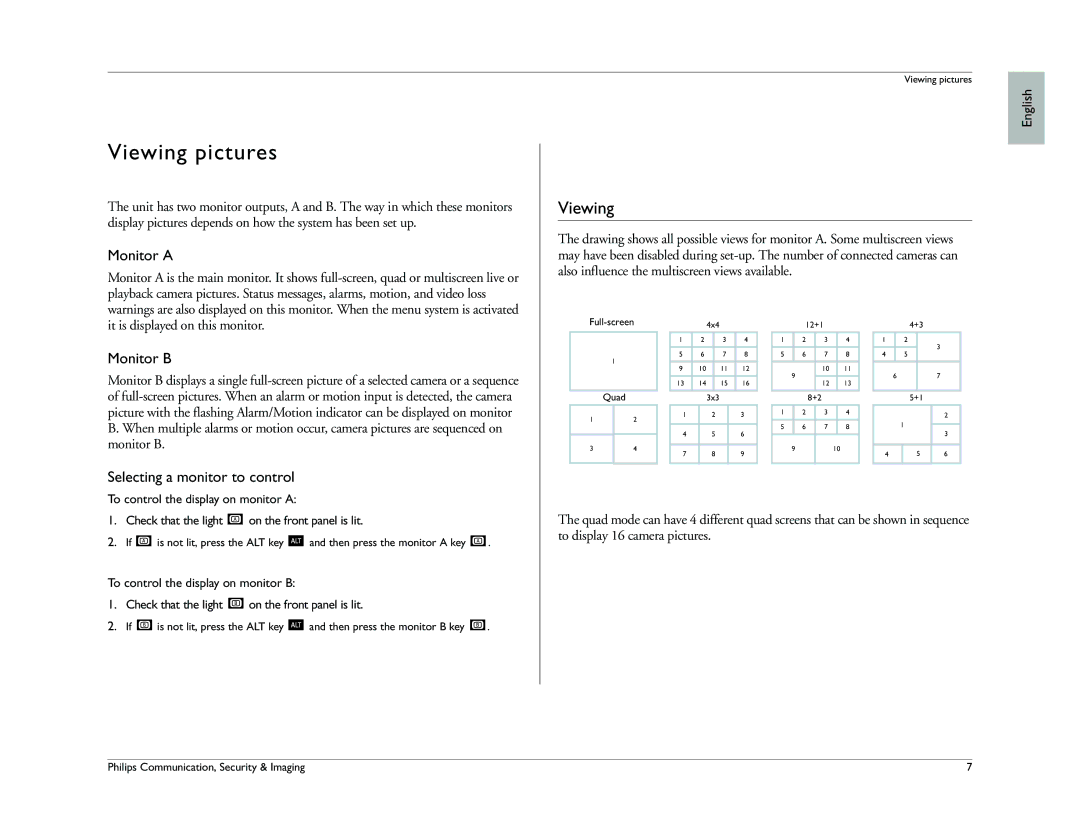
Viewing pictures
The unit has two monitor outputs, A and B. The way in which these monitors display pictures depends on how the system has been set up.
Monitor A
Monitor A is the main monitor. It shows
Viewing pictures
Viewing
The drawing shows all possible views for monitor A. Some multiscreen views may have been disabled during
English
it is displayed on this monitor.
Monitor B
Monitor B displays a single
Selecting a monitor to control
To control the display on monitor A:
1
Quad
1 | 2 |
3 | 4 |
4x4
1 | 2 |
| 3 |
| 4 | |
|
|
|
|
|
|
|
5 | 6 |
| 7 |
| 8 | |
|
|
|
|
|
|
|
9 | 10 |
| 11 |
| 12 | |
|
|
|
|
|
|
|
13 | 14 |
| 15 |
| 16 | |
|
|
|
|
|
|
|
|
|
| 3x3 |
| ||
|
|
|
|
|
| |
1 |
|
| 2 |
| 3 | |
|
|
|
|
|
| |
4 |
|
| 5 |
| 6 | |
|
|
|
|
|
| |
7 |
|
| 8 |
| 9 | |
|
|
|
|
|
|
|
| 12+1 |
|
| 4+3 |
| ||
1 | 2 | 3 | 4 | 1 | 2 | 3 | |
5 | 6 | 7 | 8 | 4 | 5 | ||
| |||||||
| 9 | 10 | 11 | 6 |
| 7 | |
| 12 | 13 |
| ||||
|
|
|
|
| |||
|
| 8+2 |
|
| 5+1 |
| |
1 | 2 | 3 | 4 |
|
| 2 | |
|
|
|
|
|
| ||
5 | 6 | 7 | 8 |
| 1 | 3 | |
|
|
|
|
|
| ||
| 9 |
| 10 | 4 | 5 | 6 | |
|
|
|
| ||||
1.Check that the light ![]() on the front panel is lit.
on the front panel is lit.
2.If ![]() is not lit, press the ALT key
is not lit, press the ALT key ![]() and then press the monitor A key
and then press the monitor A key ![]() .
.
To control the display on monitor B:
1.Check that the light ![]() on the front panel is lit.
on the front panel is lit.
2.If ![]() is not lit, press the ALT key
is not lit, press the ALT key ![]() and then press the monitor B key
and then press the monitor B key ![]() .
.
The quad mode can have 4 different quad screens that can be shown in sequence to display 16 camera pictures.
Philips Communication, Security & Imaging | 7 |
